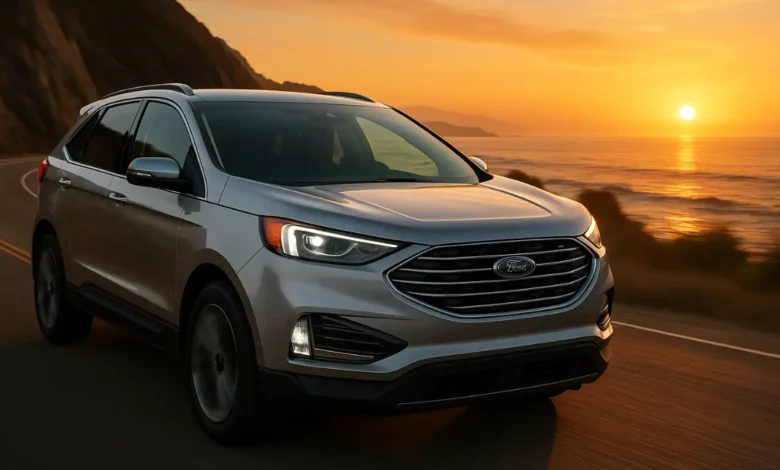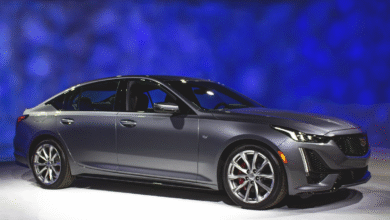Mastering Ford Edge MPG: Real-World Efficiency, Expert Insights, and Smart Driving Tips for Better Performance

Explore the complete guide to Ford Edge MPG — from real-world fuel economy, engine options, and model comparisons to expert tips for better mileage and owner experiences. Discover what truly affects your Ford Edge’s efficiency.
Understanding Ford Edge MPG
When people look at SUVs like the Ford Edge, one of the first questions that pops up is about fuel efficiency — what kind of mileage can you actually expect? The Ford Edge stands as a mid-size crossover that balances comfort, performance, and practicality. But its MPG (miles per gallon) varies depending on engine choice, drive configuration, and how it’s driven daily.
In simple terms, MPG tells you how efficiently your Ford Edge uses fuel. A higher MPG means your SUV can travel further on each gallon of gas. However, many factors — such as weather, terrain, load, and driving habits — can shift that figure up or down. Understanding Ford Edge MPG helps you not only estimate running costs but also make smarter choices about maintenance and driving style.
What MPG Really Means for Ford Edge Drivers
MPG stands for miles per gallon, which measures how many miles your car can travel using a single gallon of fuel. It’s one of the simplest yet most revealing indicators of a vehicle’s efficiency. The Ford Edge’s MPG varies by city and highway driving conditions. City driving, filled with stops and traffic lights, naturally delivers lower MPG than long, steady highway drives.
For example, when cruising on highways, your engine works efficiently at a consistent speed, using less fuel. But in the city, constant acceleration and braking force the engine to burn more gas. So, while the EPA gives you standardized figures for city, highway, and combined MPG, your real-world results can look slightly different.
Ford Edge MPG by Model and Engine Type
Not all Ford Edge models are built the same. The difference between the base trim and the sportier versions can mean a few miles per gallon difference on the road.
EcoBoost Efficiency
The 2.0-liter EcoBoost engine is the most fuel-efficient choice in the Ford Edge lineup. It offers strong acceleration with respectable fuel economy, making it ideal for daily commuters. The combination of turbocharging and direct fuel injection helps this engine deliver smooth power while maintaining good mileage.
Owners commonly report around 21 MPG in the city and 28 MPG on the highway, giving a balanced performance for both urban and long-distance driving.
Performance-Oriented ST Model
The ST trim, featuring a 2.7-liter V6 EcoBoost, is designed more for performance than economy. It provides thrilling acceleration and high torque, but naturally consumes more fuel. Typical mileage figures hover around 19 MPG in the city and 25 MPG on the highway. While that’s slightly lower, it’s expected given the extra horsepower and all-wheel-drive setup.
Older V6 Engines
Earlier models of the Ford Edge, particularly those equipped with the 3.5L and 3.7L V6 engines, often return lower mileage numbers. These older, naturally aspirated engines were less fuel-efficient compared to modern turbocharged versions. Many owners of these models report average combined MPG between 18 and 21, depending on driving conditions and maintenance.
How Drivetrain and Trim Affect MPG
The Ford Edge comes in both front-wheel drive (FWD) and all-wheel drive (AWD) variants. The drivetrain choice can slightly influence the overall MPG performance.
Front-Wheel Drive
FWD models are lighter and experience less mechanical drag, translating into better fuel efficiency. They are generally preferred for those living in warmer climates or urban settings where road conditions are predictable.
All-Wheel Drive
AWD versions, while offering improved traction and control, add extra weight and drivetrain components, slightly lowering fuel economy. For instance, the same engine in AWD form can lose one to two miles per gallon compared to its FWD counterpart. This difference might seem small, but over time it adds up in fuel costs.
Trim levels also play a role. Higher trims often come with larger wheels, added technology, and more features — all contributing to slightly reduced efficiency due to increased weight and rolling resistance.
Real-World Ford Edge MPG Experiences
While EPA ratings provide useful benchmarks, nothing beats real-life feedback from actual owners. Across driver communities, the Ford Edge generally earns praise for offering a good balance between power and efficiency for its size.
Most drivers with the 2.0L EcoBoost engine report real-world combined MPG figures between 22 and 25. Those who spend more time on highways sometimes see close to 30 MPG under ideal conditions. On the other hand, Edge ST owners report averages closer to 20 MPG, though some manage better results with gentle driving.
Owners in colder climates or with heavy commuting patterns often note slightly reduced efficiency, which is consistent with how engines respond to temperature changes and stop-and-go traffic.
Factors That Influence Ford Edge MPG
Several subtle factors can alter your fuel economy. Understanding them helps you make small adjustments that add up to noticeable savings.
Tire Pressure and Type
Underinflated tires create more rolling resistance, forcing the engine to work harder and burn more fuel. Regularly checking and maintaining proper tire pressure can improve mileage by as much as three percent. Using tires with low rolling resistance or appropriate tread patterns for your driving conditions also helps.
Driving Style
Rapid acceleration, hard braking, and idling all decrease fuel efficiency. Smooth, steady driving keeps the engine in its optimal range, improving Ford Edge MPG significantly.
Maintenance Habits
Clean air filters, fresh engine oil, and properly tuned spark plugs ensure your vehicle runs at its best. Neglecting basic maintenance can lower MPG and overall performance.
Weight and Cargo
Excess weight reduces efficiency. Removing unnecessary cargo and roof racks when not in use can instantly improve mileage.
Comparing Ford Edge MPG to Competitors
The Ford Edge competes with several other mid-size crossovers, including the Toyota Highlander, Honda Passport, and Chevrolet Blazer. In terms of fuel economy, it sits comfortably in the middle.
| Model | City MPG | Highway MPG | Combined MPG |
|---|---|---|---|
| Ford Edge (2.0L EcoBoost) | 21 | 28 | 24 |
| Toyota Highlander (2.4L Turbo) | 22 | 29 | 25 |
| Honda Passport (3.5L V6) | 19 | 24 | 21 |
| Chevrolet Blazer (2.0L Turbo) | 22 | 29 | 25 |
While some competitors have slightly higher ratings, the Edge balances efficiency with solid power and a refined cabin experience, making it a strong contender in its class.
Tips to Improve Ford Edge MPG
You can influence your SUV’s fuel economy more than you might think. Here are some practical steps to get better mileage:
- Keep up with maintenance: Regular oil changes and tune-ups keep your engine running smoothly.
- Use cruise control: On highways, this helps maintain a steady speed, saving fuel.
- Avoid excessive idling: Turn off your engine during long stops.
- Lighten the load: Remove roof racks or heavy items not needed daily.
- Use the right fuel: Stick to the recommended grade; higher octane doesn’t always mean better performance.
With these steps, many owners have managed to boost their MPG by two to three points without sacrificing comfort or performance.
Quotes from Ford Edge Owners
“I drive my 2022 Edge Titanium every day for work, mostly highway. I consistently get around 27 MPG, which I think is impressive for a vehicle of this size.”
“My Edge ST is powerful and fun, but I knew going in that performance comes with a little hit on fuel economy. Still, I average 23 MPG on longer trips, which is acceptable.”
“Switching to eco driving mode and keeping my tires properly inflated made a noticeable difference — about 2 MPG higher than before.”
Common Misconceptions About Ford Edge MPG
Some believe that all SUVs have poor mileage, but the Ford Edge challenges that stereotype. With modern turbocharging and efficient transmission systems, it achieves fuel economy close to that of smaller crossovers.
Another misconception is that premium fuel will dramatically improve efficiency. The truth is, most Ford Edge engines are designed to run efficiently on regular unleaded fuel. Using premium gas in non-turbo or low-boost engines often yields no real benefit.
Finally, some think AWD automatically means poor mileage. While AWD uses more fuel, it doesn’t necessarily ruin efficiency — proper maintenance and cautious driving minimize the difference.
Future of Ford Edge MPG and Hybrid Possibilities
As automotive technology evolves, the future of the Ford Edge’s fuel economy looks promising. Ford has already incorporated hybrid systems in models like the Escape and Explorer, and there’s speculation that future Edge generations could adopt similar systems.
Such developments could push combined MPG figures well beyond 30, offering even greater savings and environmental benefits. While the current Edge isn’t hybridized, Ford’s commitment to EcoBoost and efficiency improvements signals that the next versions may deliver a big leap forward.
FAQs about Ford Edge MPG
What is the average Ford Edge MPG?
The average combined Ford Edge MPG ranges from 22 to 25 for most recent models, depending on the engine and driving style.
Does the Ford Edge require premium fuel?
No, the Ford Edge runs efficiently on regular unleaded gasoline unless otherwise specified in the owner’s manual.
Which Ford Edge trim has the best MPG?
The base 2.0L EcoBoost front-wheel-drive version generally delivers the best fuel economy among all trims.
Can driving habits affect Ford Edge MPG?
Absolutely. Gentle acceleration, steady cruising, and timely maintenance can improve fuel efficiency by several miles per gallon.
Is the Ford Edge good for long trips?
Yes, its combination of comfort, smooth handling, and solid highway MPG makes it an excellent choice for long-distance driving.
Conclusion
The Ford Edge MPG story is one of balance — it offers respectable fuel economy for an SUV while maintaining strong performance and comfort. Whether you opt for the efficient 2.0L EcoBoost or the sportier ST model, your real-world mileage depends on driving habits, maintenance, and environmental factors.
By understanding how different factors impact your MPG, you can make small, smart choices that keep your Ford Edge performing efficiently and economically for years to come.



